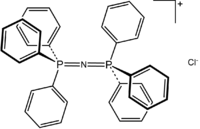µ-Nitridobis(triphenylphosphan)chlorid
µ-Nitridobis(triphenylphosphan)chlorid ist eine chemische Verbindung mit der Summenformel [((C6H5)3P)2N]Cl, die häufig als PPNCl abgekürzt wird. Das farblose Salz ist eine Quelle für das [PPN]+-Kation, welches genutzt wird, um ansonsten schwierige Anionen auszukristallisieren. [PPN]+ ist ein Phosphazen.
| Strukturformel | ||||||||||||||||
|---|---|---|---|---|---|---|---|---|---|---|---|---|---|---|---|---|

| ||||||||||||||||
| Allgemeines | ||||||||||||||||
| Name | µ-Nitrido-bis(triphenylphosphan)-chlorid | |||||||||||||||
| Andere Namen |
| |||||||||||||||
| Summenformel | C36H30ClNP2 | |||||||||||||||
| Kurzbeschreibung |
beiges Pulver[1] | |||||||||||||||
| Externe Identifikatoren/Datenbanken | ||||||||||||||||
| ||||||||||||||||
| Eigenschaften | ||||||||||||||||
| Molare Masse | 574,03 g·mol−1 | |||||||||||||||
| Aggregatzustand |
fest | |||||||||||||||
| Schmelzpunkt | ||||||||||||||||
| Sicherheitshinweise | ||||||||||||||||
| ||||||||||||||||
| Soweit möglich und gebräuchlich, werden SI-Einheiten verwendet. Wenn nicht anders vermerkt, gelten die angegebenen Daten bei Standardbedingungen (0 °C, 1000 hPa). | ||||||||||||||||
Herstellung
BearbeitenDie Darstellung von PPNCl erfolgt in zwei Schritten aus Triphenylphosphan:[3]
Das entstandene Triphenylphosphandichlorid ist ein in der organischen Chemie genutztes Chlorierungsreazenz[4], das in polaren Lösungsmitteln als Ionenpaar[5] und in unpolaren Lösungsmitteln als trigonal bipyramidales Molekül vorliegt.[6] Weitere Behandlung mit Hydroxylamin in Gegenwart eines Äquivalents Ph3P resultiert im Ersetzen der P-Cl- durch P=N-Bindungen:
Anwendung
BearbeitenPPN-Chlorid ist der wichtigste Vorläufer für weitere [PPN]+-Salze, durch Verdrängungsreaktionen können Nitrite, Azide und weitere kleine anorganische Anionen[2] mit [PPN]+ als Kation erhalten werden. Diese Salze sind in polaren organischen Lösungsmitteln löslich. [PPN]+-Salze ermöglichen die Kristallisation von Verbindungen mit Anionen, deren Metallsalze in fester Phase instabil wären.[7][8]
Einzelnachweise
Bearbeiten- ↑ a b c Datenblatt Bis(triphenylphosphoranylidene)ammonium chloride bei Sigma-Aldrich, abgerufen am 18. Oktober 2016 (PDF).
- ↑ a b A. Martinsen, J. Songstad: Preparation and Properties of Some Bis(triphenylphosphine)-iminium Salts, [(Ph3P)2N]X. In: Acta Chemica Scandinavica. A31, 1977, S. 645–650.
- ↑ J. K. Ruff, W. J. Schlientz: μ-nitrido-Bis(triphenylphosphorus)(1+) (“PPN”) Salts with Metal Carbonyl Anions. In: Inorganic Syntheses. Band XV, 1974, S. 84–90.
- ↑ e-EROS Encyclopedia of Reagents for Organic Synthesis, doi:10.1002/047084289X.rt371
- ↑ S. M. Godfrey, C. A. McAuliffe, R. G. Pritchard, J. M. Sheffield: An X-ray crystallorgraphic study of the reagent Ph3PCl2; not charge-transfer, R3P–Cl–Cl, trigonal bipyramidal or [R3PCl]Cl but an unusual dinuclear ionic species, [Ph3PCl+...Cl−…+CIPPH3]Cl containing long Cl–Cl contacts. In: Chemical Communications. 1996, S. 2521–2522, doi:10.1039/CC9960002521.
- ↑ S. M. Godfrey, C. A. McAuliffe, J. M. Sheffield: Structural dependence of the reagent Ph3PCl2 on the nature of the solvent, both in the solid state and in solution; X-ray crystal structure of trigonal bipyramidal Ph3PCl2, the first structurally characterised five-coordinate R3PCl2 compound. In: Chemical Communications. 1998, S. 921–922, doi:10.1039/a800820e.
- ↑ J. K. Ruff: Chemistry of the dinuclear carbonyl anions. II. Mixed-metal derivatives. In: Inorganic Chemistry. Band 7, 1968, S. 1818–1821, doi:10.1021/ic50067a023.
- ↑ L. B. Handy, J. K. Ruff, L. F. Dahl: Structural characterization of the dinuclear metal carbonyl anions [M2(CO)10]2− (M = chromium, molybdenum) and [Cr2(CO)10H]−. Marked stereochemical effect of a linearly protonated metal-metal bond. In: Inorganic Chemistry. Band 92, 1970, S. 7312–7326, doi:10.1021/ja00728a014.
